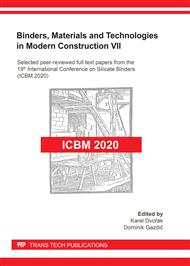p.98
p.104
p.113
p.119
p.125
p.131
p.137
p.143
p.150
The Influence of Shrinkage-Reducing Additives on Volume Changes and Mechanical Parameters of a Concrete Composite
Abstract:
Cement hydration is a process during which the setting and hardening of cement stone occur. This process is linked to the significant development of heat of hydration, which is accompanied by volume changes of concrete composite (i.e. shrinkage). Due to this, cracks in a concrete composite can arise and influence not only its durability, mechanical parameters or aesthetics but, in the case of water-tight concretes (e.g. the so-called white boxes), also its function. The extent of volume changes can be influenced not only by the composite structure itself or the selection and amount of cement but also by using suitable active additions, e.g. high-temperature fly ash. As a result, it is possible to reduce the amount of cement required while maintaining identical mechanical parameters of concrete and, at the same time, slow down the progress of heat of hydration during cement hydration. One of the other options to eliminate volume changes in concrete composites is the use of shrinkage-reducing additives (SRA). This article focuses on the SRA influence on volume changes of high-performance concretes and their impact on the development of hydration temperatures and mechanical parameters of composites.
Info:
Periodical:
Pages:
125-130
Citation:
Online since:
October 2021
Authors:
Price:
Сopyright:
© 2021 Trans Tech Publications Ltd. All Rights Reserved
Share:
Citation:


